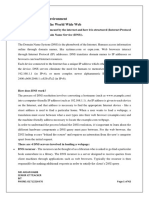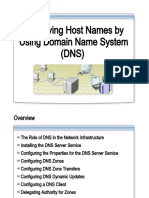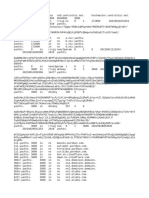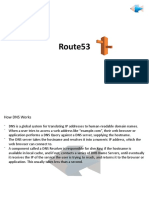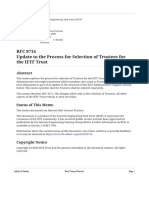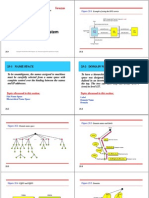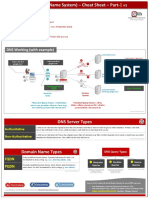1 Crafted By Abhishek Kumar Chaudhary
D.N.S
(Domain Name System)
[What, How and Where]
What is DNS? (Normal and in terms of Networking)
It is like the phonebook of the internet.
• It translates human-readable names like www.google.com or any Other URL
→ into machine-readable IP addresses like 142.250.64.100
So instead of remembering numbers (IP addresses), you just type a name — DNS finds the right
number for you.
Now Technical Definition:
(DNS) is a distributed hierarchical system that maps:
• Domain names → IP addresses (via A/AAAA records)
• IP addresses → Domain names (via PTR records)
Also handles things like:
• Mail routing (MX records)
• Aliases (CNAME records)
• Service discovery (SRV records)
• Text/config info (TXT records)
***We Will Study about records in later in this Guide***
Some Popular DNS Providers:
Provider Primary DNS Secondary DNS Features
Google DNS 8.8.8.8 8.8.4.4 Fast, reliable, minimal logging
Privacy-focused, DNS over HTTPS
Cloudflare 1.1.1.1 1.0.0.1
(DoH), DoT
Parental control, phishing
OpenDNS 208.67.222.222 208.67.220.220
protection
Quad9 9.9.9.9 149.112.112.112 Security and malware filtering
CleanBrowsing 185.228.168.9 185.228.169.9 Family-safe DNS filtering
Comodo Secure DNS 8.26.56.26 8.20.247.20 Malware and phishing protection
https://www.linkedin.com/in/abhishek-chaudhary-48997510b/
�2 Crafted By Abhishek Kumar Chaudhary
Servers Role in DNS Operation
1-Recursive Resolver
o First server your device talks to.
o Does all the work of finding the answer by querying other DNS servers on your behalf.
Meaning:
Scenario: You type www.abhishekchaudhary.com into your web browser.
Your Device Talks to the Recursive Resolver First:
• Your computer doesn't know the IP address for www. abhishekchaudhary.com.
• It's configured to use a specific Recursive Resolver (let's say its IP address is 8.8.8.8,
which is Google's Public DNS).
• Your computer sends a query to 8.8.8.8 asking, "What's the IP address for www.
abhishekchaudhary.com?"
2-Root DNS Servers
o Top of the DNS hierarchy.
o They don’t know domain IPs, but they tell you where to find TLD servers (like .com, .org).
Meaning:
Continuing above example
You typed www.abhishekchaudhary.com into your web browser, and your Recursive Resolver
(let's say 8.8.8.8) has received your query.
1. Your Device Talks to the Recursive Resolver First (as before):
• Your computer asks 8.8.8.8, "What's the IP address for www.abhishekchaudhary.com?"
2. The Recursive Resolver Starts Its Work – And Immediately Consults a Root DNS Server:
• Recursive Resolver (8.8.8.8) receives your query.
• It doesn't know the answer directly. It’s very first step in its iterative query process is to
contact a Root DNS Server.
• Role of the Root DNS Server in Action:
o 8.8.8.8 asks one of the Root DNS Servers (e.g., A.ROOT-SERVERS.NET, whose IP
address is hardcoded into almost all recursive resolvers): "I need to resolve
www.abhishekchaudhary.com. Can you tell me where to find the authoritative
information for this?"
o The Root DNS Server's Response (Crucial Role): The Root DNS Server doesn't
know the IP address for www.abhishekchaudhary.com itself. Its job is to point the
https://www.linkedin.com/in/abhishek-chaudhary-48997510b/
�3 Crafted By Abhishek Kumar Chaudhary
recursive resolver to the next level in the hierarchy. It looks at the .com part of
www.abhishekchaudhary.com and replies: "I don't know the IP for
www.abhishekchaudhary.com, but I can tell you that the servers responsible for
the .com Top-Level Domain (TLD) are located at these IP addresses (e.g.,
192.0.2.10, 192.0.2.11, etc. - these are the TLD Name Servers for .com).
3. TLD DNS Servers (Top-Level Domain Servers)
o Handle extensions like .com, .net, .org, .in, etc.
o They tell you which authoritative name server holds records for your domain.
Meaning:
Continuing above example
The Recursive Resolver Now Consults a TLD DNS Server (This is where the TLD's role comes
in):
• Recursive Resolver (8.8.8.8) now takes the information from the Root Server. It chooses
one of the .com TLD DNS Servers (let's say 192.0.2.10).
• Role of the TLD DNS Server in Action:
o 8.8.8.8 sends a query to 192.0.2.10 (a .com TLD DNS Server): "I need to find
www.abhishekchaudhary.com Can you tell me which servers are authoritative for
abhishekchaudhary.com?"
o The TLD DNS Server's Response (Crucial Role): The .com TLD DNS Server doesn't
know the IP address for www.abhishekchaudhary.com itself. Its job is to manage
all the domains ending in .com. It looks at abhishekchaudhary.com (the second-
level domain) and knows which specific servers are responsible for holding the
records for that particular domain.
o It replies: "I don't have the IP for www.abhishekchaudhary.com, but the
Authoritative Name Servers for the abhishekchaudhary.com domain are
ns1.abhishekchaudhary.com (with IP 203.0.113.5) and
ns2.abhishekchaudhary.com (with IP 203.0.113.6)."
4. The Recursive Resolver Continues its journey (now knowing where to find the authoritative
servers for abhishekchaudhary.com):
• Armed with the IP addresses of the authoritative name servers for
abhishekchaudhary.com, the Recursive Resolver (8.8.8.8) will then proceed to query one
of those authoritative servers to get the final IP address for
www.abhishekchaudhary.com.
https://www.linkedin.com/in/abhishek-chaudhary-48997510b/
�4 Crafted By Abhishek Kumar Chaudhary
4- Authoritative DNS Servers
o The final and actual source of truth.
o They store DNS records (like A, AAAA, CNAME, MX, etc.) for a domain.
Meaning:
Continuing above example
The Recursive Resolver Now Consults an Authoritative DNS Server (This is where the final
answer is found):
• Recursive Resolver (8.8.8.8) now takes the information from the TLD Server. It chooses
one of the authoritative DNS servers for example.com (let's say 203.0.113.5, which is
ns1.abhishekchaudhary.com).
• Role of the Authoritative DNS Server in Action:
o 8.8.8.8 sends a query directly to 203.0.113.5 (the Authoritative DNS Server for
abhishekchaudhary.com): "What is the IP address for
www.abhishekchaudhary.com?"
o The Authoritative DNS Server's Response (The Final Truth): This server is the
"source of truth" for all records within the abhishekchaudhary.com domain. It
has a comprehensive list of all DNS records for abhishekchaudhary.com, including
www.abhishekchaudhary.com. It finds the specific record.
o It replies: "The IP address for www.abhishekchaudhary.com is 192.0.2.1." (This is
an "A" record, mapping a hostname to an IPv4 address).
5. The Recursive Resolver Delivers the Answer to Your Device:
• The Recursive Resolver (8.8.8.8) now has the definitive IP address: 192.0.2.1.
• It sends this IP address back to your computer/laptop.
• Your computer then uses 192.0.2.1 to establish a connection with the web server
hosting www.abhishekchaudhary.com and load the website content.
5- Local DNS Cache
o Before any network query, your browser or OS may cache DNS answers to improve
speed.
o Not a DNS server per se, but it can answer queries without any external request.
Meaning:
Continuing above example
https://www.linkedin.com/in/abhishek-chaudhary-48997510b/
�5 Crafted By Abhishek Kumar Chaudhary
You've previously visited www.abhishekchaudhary.com. Now, you want to visit it again.
1. Your Device Initiates a Query (and Checks its Local Cache First):
• You type www.abhishekchaudhary.com into your web browser (or click a link to it).
• Role of Local DNS Cache in Action:
o Browser Cache: Your web browser (e.g., Chrome, Firefox) first checks its own
internal DNS cache. If it recently resolved www.abhishekchaudhary.com and the
TTL (Time-To-Live) for that entry hasn't expired, it will find the IP address
(192.0.2.1) right there.
o Operating System (OS) Cache: If the browser cache doesn't have it, or if the
browser is configured to defer to the OS, your operating system (e.g., Windows,
macOS, Linux) checks its own DNS cache. Again, if the IP address for
www.abhishekchaudhary.com (192.0.2.1) is stored and still valid, it will be
retrieved from here.
Scenario A: Cache Hit (The Good, Fast Path!!!!!!!)
• If the IP address for www.abhishekchaudhary.com (i.e., 192.0.2.1) is found in your
browser's or OS's local DNS cache and is still valid (not expired):
o Your device immediately uses 192.0.2.1 to connect directly to the web server
hosting www.abhishekchaudhary.com.
o No external DNS queries are made. This is why subsequent visits to the same
website often load much faster! The entire process involving the Recursive
Resolver, Root Servers, TLD Servers, and Authoritative Servers is completely
bypassed/Skipped.
Scenario B: Cache Miss (Back to the Full Resolution Process), as discussed above
What Are the 13 Root Servers?
There are 13 logical root server names, labeled from A to M.
Root Server Operator Example Root Server Name
A Verisign, Inc. a.root-servers.net
USC-ISI (University of Southern
B b.root-servers.net
California)
C Cogent Communications c.root-servers.net
D University of Maryland d.root-servers.net
E NASA Ames Research Center e.root-servers.net
F Internet Systems Consortium (ISC) f.root-servers.net
G U.S. Department of Defense (DISA) g.root-servers.net
https://www.linkedin.com/in/abhishek-chaudhary-48997510b/
�6 Crafted By Abhishek Kumar Chaudhary
H U.S. Army Research Lab h.root-servers.net
I Netnod (Sweden) i.root-servers.net
J Verisign, Inc. j.root-servers.net
K RIPE NCC (Europe) k.root-servers.net
L ICANN l.root-servers.net
M WIDE Project (Japan) m.root-servers.net
Importance:
o They serve the root zone file, which contains pointers to all Top-Level Domains (TLDs)
like .com, .org, .net, etc.
o Without them, DNS resolution wouldn’t know where to begin.
o They’re duplicated globally using anycast, not just 13 physical machines.
Types of Records in DNS
Record Type Purpose Example
Maps a domain name to an IPv4 example.com →
A (Address)
address 93.184.216.34
Maps a domain name to an IPv6 example.com →
AAAA
address 2606:2800:220:1:248
CNAME Alias of another domain name www → myapp.hosting.net
mail.example.com priority
MX Mail server for a domain
10
Specifies name servers for the
NS ns1.exampledns.com
domain
Reverse lookup: IP address → 34.216.184.93.in-addr.arpa
PTR
domain name → example.com
Start of Authority — contains Primary NS, admin email,
SOA
zone info serial #
Text info (for SPF, DKIM, "v=spf1
TXT
verification) include:_spf.google.com"
Now, Understand each Record with Example:
1. A (Address) Record
• Purpose: Maps a domain name or hostname to an IPv4 (32-bit) address. This is the most
fundamental record for pointing a domain to a server.
https://www.linkedin.com/in/abhishek-chaudhary-48997510b/
�7 Crafted By Abhishek Kumar Chaudhary
Example:
• example.com. IN A 192.0.2.1
• www.example.com. IN A 192.0.2.1
• mail.example.com. IN A 192.0.2.2
o Explanation: When someone tries to access example.com or www.example.com,
their browser will be directed to the server at IPv4 address 192.0.2.1. Similarly,
mail.example.com points to 192.0.2.2.
2. AAAA (Quad-A) Record
• Purpose: Maps a domain name or hostname to an IPv6 (128-bit) address. This is the IPv6
equivalent of an A record.
Example:
• example.com. IN AAAA 2001:0db8:85a3:0000:0000:8a2e:0370:7334
• www.example.com. IN AAAA 2001:0db8:85a3:0000:0000:8a2e:0370:7334
o Explanation: Similar to an A record, but for IPv6. When a device request
example.com and prefers IPv6, it will be directed to
2001:0db8:85a3:0000:0000:8a2e:0370:7334.
3. CNAME (Canonical Name) Record
• Purpose: Creates an alias from one domain name to another. When a DNS resolver
queries a CNAME record, it will then perform a new lookup for the aliased name.
Example:
• blog.example.com. IN CNAME example.wordpress.com.
• www.example.com. IN CNAME example.com.
o Explanation:
▪ blog.example.com is an alias for example.wordpress.com. If you try to
access blog.example.com, the DNS resolver will then look up the IP
address for example.wordpress.com.
▪ www.example.com is an alias for example.com. This is common to ensure
both example.com and www.example.com point to the same resource.
4. MX (Mail Exchange) Record
• Purpose: Specifies the mail servers responsible for accepting email messages on behalf
of a domain. MX records also include a "preference" value (lower is preferred) to
indicate priority if multiple mail servers are listed.
Example:
• example.com. IN MX 10 mail.example.com.
• example.com. IN MX 20 backup-mail.example.com.
o Explanation: When an email is sent to user@example.com, the sending mail
server will first try to deliver it to mail.example.com (preference 10). If that fails,
it will then try backup-mail.example.com (preference 20). Note that
https://www.linkedin.com/in/abhishek-chaudhary-48997510b/
�8 Crafted By Abhishek Kumar Chaudhary
mail.example.com and backup-mail.example.com would also need their own A or
AAAA records.
5. NS (Name Server) Record
• Purpose: Specifies the authoritative DNS servers for a domain. These are the servers
that hold the actual DNS records for that domain. They delegate authority for a zone.
Example:
• example.com. IN NS ns1.example.com.
• example.com. IN NS ns2.example.com.
o Explanation: These records tell other DNS servers (like TLD servers) that
ns1.example.com and ns2.example.com are the servers responsible for providing
DNS information about anything within the example.com domain.
ns1.example.com and ns2.example.com would also have corresponding A or
AAAA records (sometimes called "glue records").
6. PTR (Pointer) Record
• Purpose: Maps an IP address to a domain name. This is used for reverse DNS lookups,
primarily for anti-spam measures and logging. It's the inverse of an A or AAAA record.
PTR records are configured in special reverse DNS zones, often managed by the IP
address owner (ISP or hosting provider).
Example (for IP 192.0.2.1):
• 1.2.0.192.in-addr.arpa. IN PTR www.example.com.
o Explanation: If a mail server receives an email from 192.0.2.1, it might perform a
reverse DNS lookup. This PTR record would tell it that 192.0.2.1 corresponds to
www.example.com. Note the reversed IP octets and the .in-addr.arpa suffix for
IPv4 reverse lookups.
7. SOA (Start of Authority) Record
• Purpose: Provides authoritative information about a DNS zone, including the primary
name server, the email address of the domain administrator, the domain serial number,
and various timers (e.g., refresh, retry, expire, TTL). Every zone must have exactly one
SOA record.
Example:
• example.com. IN SOA ns1.example.com. admin.example.com. (
• 2024060101 ; Serial
• 7200 ; Refresh (2 hours)
• 3600 ; Retry (1 hour)
• 1209600 ; Expire (2 weeks)
• 3600 ; Minimum TTL (1 hour)
o Explanation:
▪ ns1.example.com.: The primary name server for this zone.
https://www.linkedin.com/in/abhishek-chaudhary-48997510b/
�9 Crafted By Abhishek Kumar Chaudhary
▪ admin.example.com.: The email address of the person responsible for this
zone (the first dot . is replaced by @).
▪ Serial: A version number that must be incremented each time the zone
file is updated. This tells secondary DNS servers when to refresh their
copy.
▪ Refresh: How often secondary name servers should check for updates.
▪ Retry: How long secondary name servers should wait before retrying a
failed refresh.
▪ Expire: If a secondary server fails to refresh its data after this time, it
should no longer answer queries for the zone.
▪ Minimum TTL: The default TTL for any records in the zone that don't have
their own TTL specified.
8. TXT (Text) Record
• Purpose: Holds arbitrary human-readable text information or machine-readable data for
various purposes. They are often used for verification, security, and policy settings.
Example:
• example.com. IN TXT "v=spf1 include:_spf.google.com ~all"
• _dmarc.example.com. IN TXT "v=DMARC1; p=quarantine; rua=mailto:dmarc-
reports@example.com"
• _acme-challenge.www.example.com. IN TXT "random_string_for_cert_verification"
o Explanation:
▪ The first example is a Sender Policy Framework (SPF) record, used to
prevent email spoofing by specifying which mail servers are authorized to
send email on behalf of example.com.
▪ The second is a DMARC record, used for email authentication and
reporting policies.
▪ The third example is often used for domain verification by services like
Let's Encrypt for issuing SSL certificates.
Important Points:
▪ A and CNAME: You can't have both for the same domain (e.g., www) — it's either
one or the other.
▪ CNAME must always point to a domain name, not an IP address.
▪ TXT records are widely used for verification (e.g., Google site verification, SPF, DKIM,
etc.).
https://www.linkedin.com/in/abhishek-chaudhary-48997510b/
�10 Crafted By Abhishek Kumar Chaudhary
Some Common DNS Command Line tool for troubleshooting
1. DIG (Domain Information Groper)
▪ Powerful, flexible, and commonly used on Linux, macOS, and even Windows (via WSL or
install).
▪ Let you query specific DNS record types (A, MX, TXT, etc.).
▪ Shows detailed information, like query time, flags, and authoritative responses.
2. NSLOOKUP (Name server Lookup)
▪ It is a command-line tool used for querying the Domain Name System (DNS) to obtain
domain name or IP address mapping.
▪ most common use is to find the IP address associated with a given domain name.
▪ It can also take an IP address and attempt to find the domain name associated with it.
A typical nslookup output will show:
Server
Address
Non-authoritative answer
Authoritative answer
Name
Addresses (or Address)
Aliases
3. set q=all in nslookup
▪ A command within nslookup interactive mode.
▪ It sets the query type to ALL, meaning it will try to return all DNS records available for a
domain.
https://www.linkedin.com/in/abhishek-chaudhary-48997510b/
�11 Crafted By Abhishek Kumar Chaudhary
TTL Value Concept (very Important)
TTL (Time to Live) is a value (in seconds) that tells DNS resolvers how long to cache a DNS record
before requesting a fresh copy from the authoritative DNS server.
Simple terms:-> TTL controls how long other DNS servers (like ISPs, Google DNS, Cloudflare)
should remember a DNS record (like A, CNAME, MX, etc.).
For example-: You have “A Record” for www.abhishekchaudhary.com with TTL=3600
www.abhishekchaudhary.com. IN A 192.0.2.10 TTL = 3600
➢ This means caching DNS resolvers (like 8.8.8.8 or your ISP's DNS) will remember that
www.abhishekchaudhary.com maps to 192.0.2.10 for 1 hour (3600 seconds).
➢ After that, they'll ask again from the authoritative server.
Key Points/Best Practices to Remember while Doing any DNS Changes or doing any Migration
Activity.
▪ A few days before migration, lower the TTL (e.g., to 300 seconds).
▪ This ensures resolvers only cache records for 5 minutes.
▪ Then, when you make the change, most users will see the new IP quickly.
▪ After successful migration, you can increase the TTL again (e.g., to 3600 or 86400) to
reduce DNS traffic.
What is DNS Traffic
DNS traffic refers to the data packets exchanged between computers and DNS servers during
DNS resolution — the process of translating a domain name into an IP address.
Here's How It Works (Simplified Flow):
1. You type www.google.com in a browser.
2. Your device sends a DNS query (e.g., “What is the IP for www.google.com?”).
3. That query travels to a DNS resolver (like 8.8.8.8 or your ISP).
https://www.linkedin.com/in/abhishek-chaudhary-48997510b/
�12 Crafted By Abhishek Kumar Chaudhary
4. The resolver looks up the DNS records and sends back a response (IP address).
5. The browser uses that IP to connect to the web server.
This query–response exchange is DNS traffic.
Why DNS Traffic Matters?
• It's the first step in every internet request.
• Heavy DNS traffic might indicate:
o High website usage
o DNS misconfiguration
o DNS-based attacks (e.g., DDoS, amplification attacks)
Is DNS Traffic Secure?
By default, no — DNS traffic is unencrypted.
That’s why many systems now use:
• DoH (DNS over HTTPS)
• DoT (DNS over TLS)
• These protect DNS queries from snooping, spoofing, or tampering
Top DNS Management Consoles & Providers (Web-Based)
Platform Description
Leader in DNS, DHCP, IPAM (DDI); robust UI,
Infoblox
automation, and security tools
Competes with Infoblox; full DDI solution
BlueCat
with great automation support
GUI via DNS Manager (MMC); widely used in
Microsoft DNS (Windows Server)
corporate AD environments
DNS/DHCP/IPAM with hybrid cloud support
Men & Mice
and web console
EfficientIP Advanced DNS security and DDI automation
https://www.linkedin.com/in/abhishek-chaudhary-48997510b/
�13 Crafted By Abhishek Kumar Chaudhary
Cloud DNS Providers (Public Internet-Facing):
Provider Console / Platform Name Notes
Highly available, scalable,
AWS Route 53 AWS Console supports latency/routing
policies
Fast DNS + WAF, DDoS
Cloudflare DNS Cloudflare Dashboard
protection, CDN integration
Highly scalable, integrated
Google Cloud DNS Google Cloud Console
with GCP
Integrated with Microsoft
Azure DNS Azure Portal
Azure services
Simple and developer-
DigitalOcean DNS DigitalOcean Control Panel
friendly
Namecheap / GoDaddy / Web dashboards for DNS record Easy but less advanced
others management (good for basic domains)
Open Source/Self-Hosted:
Tool Description
PowerDNS (with PowerAdmin) Popular open-source DNS server + web GUI
Bind9 + Webmin Classic BIND DNS with web-based admin tool
Local DNS sinkhole with web UI, often used for
Pi-hole (for home DNS)
blocking ads
References:
https://data.iana.org/TLD/tlds-alpha-by-domain.txt
https://www.icann.org/en/contracted-parties/registry-operators/resources/list-of-top-level-
domains
https://www.cloudflare.com/learning/dns/what-is-dns/
https://www.linkedin.com/in/abhishek-chaudhary-48997510b/
�14 Crafted By Abhishek Kumar Chaudhary
https://www.linkedin.com/in/abhishek-chaudhary-48997510b/



